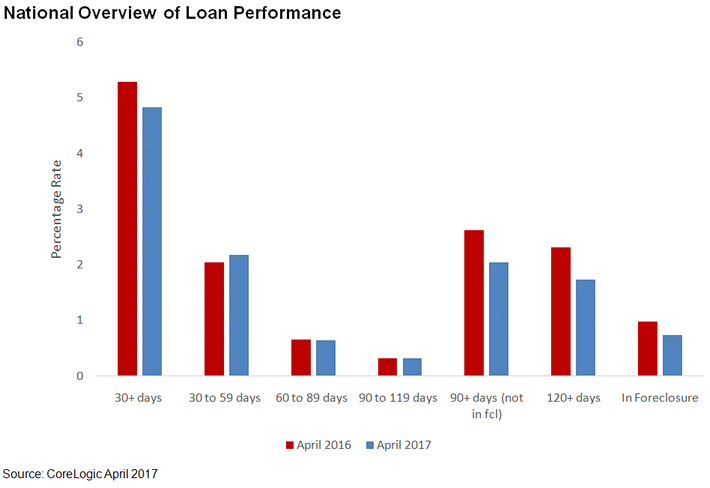While the overall percentage of non-current mortgage loans declined over the 12 months that ended in April, there was an uptick of those in the early stages of delinquency. CoreLogic's Loan Performance Insights Report for April notes a half-point decline in the overall mortgage delinquency rate, to 4.8 percent. In April 2016 the rate, which includes loans 30 or more days past due, including those in foreclosure, was 5.3 percent.
Early stage delinquencies, those 30 to 59 days past due, increased from 2.0 percent of all mortgages in April of 2016 to 2.2 percent. Loans that were 60 to 89 days overdue slipped from 0.64 percent to 0.63 percent. Serious delinquencies, defined as loans more than 90 days past due and/or in foreclosure declined from 2.6 percent to 2.0 percent over the course of the year. The rate of loans in the process of foreclosure, the so-called foreclosure inventory, was down to 0.7 percent, a year-over-year change of -0.3 percent.

CoreLogic says tracking early-stage delinquencies is important to analyzing the health of the mortgage market, as is the transition of mortgages moving from one stage of delinquency to the next. The share of mortgages that transitioned from current to 30-days past due was 1.2 percent in April 2017 compared with 1 percent in April 2016. By comparison, in January 2007, just before the start of the financial crisis, the current-to-30-day transition rate was 1.2 percent and it peaked in November 2008 at 2 percent.
Delinquency rates vary enormously among states. In April Mississippi had the highest rate at 8.6 percent, followed by Louisiana at 8.3 percent and New Jersey at 7.5 percent. Nine others had rates between 6 and 7 percent. The lowest rates were in North Dakota at 2.1 percent and Colorado at 2.3 and four other states, South Dakota, Washington, Oregon, and Montana had rates between 2.5 and 2.8 percent.
"Most major indicators of mortgage performance improved in April, showing that the market continues to benefit from improved economic growth and home price increases," said Dr. Frank Nothaft, chief economist for CoreLogic. "Regionally, with the exception of several energy industry intensive states - Alaska and North Dakota - the rest of the U.S. continues to see improvements in mortgage performance. While overall performance is improving, it reflects the older legacy pipeline of loans that continue to heal, especially in judicial states which typically take longer to clear out."
"Delinquency rates are down virtually across the board as the rebound in the U.S. housing market continues to gather steam. It appears likely that delinquency rates will continue to fall for some time, but at a moderating pace," said Frank Martell, president and CEO of CoreLogic. "As we look forward, improved fundamentals provide us with a firm foundation and we must now increase our attention to carefully expand the supply of affordable housing stock and ensure that mortgage lending policies help to prudently promote first-time homeownership."







